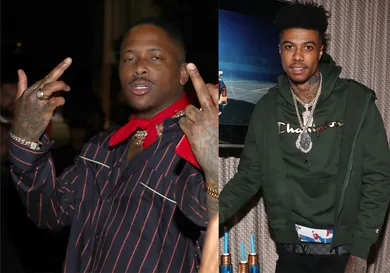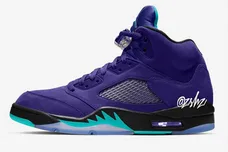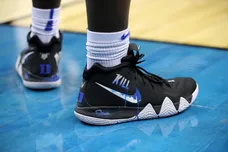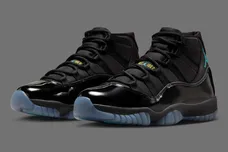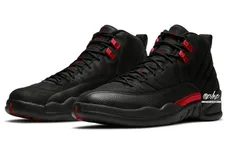In the third episode of his acclaimed Netflix series Trigger Warning, Run The Jewels’ Killer Mike unveiled his desire to overhaul America’s perception of the Crips and Bloods. Citing notorious motorcycle club The Hell’s Angels as a prime example, the Atlanta MC believes that the time has come for these vilified gangs to be legitimized as “street fraternities.” Where the leather-clad outlaws have been ingratiated to middle America through merchandising, Mike believed that the red and blue sides should enter through the carbonated drink game.
Dubbed “Crip-A-Cola” and “Blood-Pop,” Mike’s attempt at bringing the gangs into the corporate world prodded at moral panic, racial prejudice and “white gang privilege” in a thoughtfully satirical fashion. In his own words, he aimed to address a disparity between the black community and other ethnic groups:
“My Italian friends will proudly say that their grandfathers ran with the Mafia. And in America, we love the bad guy. Even the good guys, we want them to kick ass like a bad guy. So what is it about the psychology of my community that didn’t allow us to embrace our bad guys in that way?”
Entertaining and thought-provoking as it was, his social experiment discounted a major export of both cliques that’s taken them right into the cultural heart of America. Since the dawning of West Coast gangsta rap, the South-Central origins of both gangs and their inner-city warfare have been an omnipresence in the genre. Just like any other point of reference, there have been ebbs and flows for their prevalence in the mainstream but we’ve found ourselves in the middle of a drastic upswing over the past year or so. Whether it’s manifested in the auspicious rise of Blueface, the 6ix9ine-Treyway legal debacle or in self-professed Blood member Cardi B’s rise to superstardom, these mortal enemies have been recemented on the commercial hip-hop map in a way that hasn’t been seen since the days of The Game & Lil Wayne’s “Red Nation”. Rather than stepping into the corporate world as Mike suggested, the art of rap has been a time-honoured means for Crip and Piru affiliates to convey their surroundings to the wider world without defanging its more dangerous attributes. In fact, hip-hop has not only been an escape route but is deployed as a unifying force that far exceeds any other peace offering.
Mike Concepcion at the Hip-Hop Summit Presents 3rd Annual Action Awards - Johnny Nunez/WireImage/Getty Images
When it comes to brokering truces, there is a longstanding history of MCs using their position as leaders and spokespeople to address gang violence head-on. Produced by Crip OG Mike Concepcion himself, an elite team of rappers came together under the moniker of “West Coast Rap All-Stars” to deliver “We’re All In The Same Gang.” Featuring everyone from King Tee, Tone-Loc, Ice-T and 3/4'ths of N.W.A to more pop-oriented acts such as Digital Underground, Young MC and MC Hammer, the seven-minute track aimed to highlight the futility of fighting over colours in favour of progressing as one. The Californian equivalent of KRS-ONE’s East Coast-based “Stop The Violence” Movement, this Grammy-nominated track would set the tone for more robust attempts to congregate on a beat.
Conceived as a response to N.W.A’s exploitation of gang culture to their own ends, rap collective Bloods & Crips were founded in 1993 with the intention of bringing authenticity to the game. In the pursuit of fair representation, the group was formed of real members that showed off their rhyming prowess at an open try-out. Built from the grassroots, the group -- comprised of Crips Tweedy Bird Loc, Att Will, Blue Ragg and Bloods O.Y.G Redrum 781, Big Wy and Bloody Mary among many others-- released a trilogy of albums entitled Bangin On Wax between 1993 and 2014 that saw the rivals trade verses about their sets without any threat of grave consequences. Although they only reached meagre heights in the charts, it’s not success that is their greatest legacy but the message of coexistence. A few years on, Ice Cube would repeat the feat when he aligned Queen Street Blood Mack 10 and 111 Neighbourhoods Crip WC under the banner of Westside Connection. In recent history, this spirit of tearing down enemy lines for collaboration has been brought to the fore by Blueface’s “Thotiana” remix with Blood members Cardi B and YG. With their affiliations worn on their sleeve, the track proves that these perfunctory differences can be put aside in the name of paving a brighter future for all parties.
YG at the 2018 BET Awards - Leon Bennett/Getty Images
Whilst a one-time collaboration can be a talking point, there is no crew that heeds the example of Bangin’ On Wax better than Top Dawg Entertainment. Under the watchful eye of Anthony Tiffith-- the nephew of Mike Concepcion no less-- a diverse mix of gang diaspora would come together for one common goal. Constituted of 52 Hoover Crip Schoolboy Q and Bounty Hunter Blood Jay Rock among others, TDE has nurtured a melting pot environment that’s a microcosm of Cali as a whole rather than defined by ingrained hatred. As tightknit as they are today, Tiffith told VIBE that in-fighting between two different Blood factions made things uneasy for Kendrick Lamar and Jay Rock at the outset:
“It was a little tension with Kendrick and Jay Rock early on because our ’hoods were going at each other. They didn’t know how to react. With me being the big homie [I would advise them]: ‘You guys can bridge the gap between the ’hood, because y’all can speak to the world now.’ You can get some money and change all this gangbang shit”
Little did they know, that’s exactly what he and Black Hippy would do. When it comes to K-Dot, Jay, Ab-Soul and Q, their own experiences can be expressed on a posse cut without infringing on another member’s tales of crime-laden communities and youthful misadventures. By creating a case study in unification, the group proves that a Blood or Crip can prosper in your circle without being to your detriment. Epitomized by Kendrick’s “neutral” sneaker release and the “I” single artwork, the group, alongside Crip-affiliated signee Reason, carry the torch for peace movements while refusing to disavow the past that made them.
From B-Real to Jim Jones, Gucci Mane, Young Jeezy, Maxo Kream and Scarface, there are countless rappers who’ve never cloaked their gang ties but didn’t allow it to become the focal point of their career or identity. In terms of how to navigate this divide, few have left a more glowing example than the LBC’s Snoop Dogg. With one of the most varied resumes in hip-hop, The Doggfather was capable of founding a Crip-centric rap group in Tha Dogg Pound before donning a cupcake suit to collaborate with Katy Perry years down the line. Before it seemed like an industry accolade, Snoop brought cripping into the homes of suburban America but never lost sight of keeping the hood life in the rear-view. Flanked by Piru member The Game and a whole host of gang-tied MCs, Snoop said it best during a 2005 summit:
"I felt we should come together as one, organize, unify and start making records with each other and be about a cause. It's time for us to start standing up for something. It's called Protect the West. We're all moving together, we ended all our beefs."
Even considering Snoop’s advice and the weight it held, that’s not to say that Crip and Blood-affiliated MCs have got the transition from gang life to rap life down to a fine art. For every success story, there’s just as many who fall foul of the thin line between sermonising your past and falling back into its grasp. From toast of the charts to serving five years, the cautionary tale of Bobby Shmurda is one that did little to deter Tekashi 6ix9ine’s involvement with the street life and reports suggest that Blueface may also be derailed by a bid on the horizon.
In a genre that places such a high premium on authenticity, Crip or Blood affiliation needn’t be an obstacle to success. Away from Killer Mike’s plan to turn street gangs into soda giants, hip-hop has provided an avenue for its members to take themselves out of the firing line whilst paying respect to those that never got the chance. At its best, music from both sides of the divide doesn’t unreservedly glamorize the gangbanging lifestyle but examines the sense of purpose or belonging that young men and women that are cast out from society find within it. As a form of social commentary, this distinct take on gangsta rap will always have its place in the hip-hop sphere. Let’s just hope that the next generation of Crip and Blood rappers err towards the thoughtful side of TDE rather than those fateful missteps of Tekashi.
